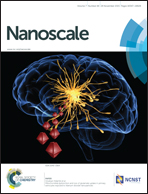A luminescent down-shifting and moth-eyed anti-reflective film for highly efficient photovoltaic devices†
Abstract
Adhesive polydimethylsiloxane (PDMS) films were developed to increase the performance of photovoltaic devices. The films combined two separate features of moth-eye patterns to reduce the reflection of incident light at the film surface and luminescent down-shifting (LDS) CdZnS/ZnS-core/shell quantum dots (QDs) to convert ultraviolet (UV) radiation into visible light at 445 nm. The films were both flexible and self-adhesive, easily attachable to any surface of a solar cell module. By simply attaching the developed films on high-efficiency GaAs solar cells, the short circuit current density and power conversion efficiency of the solar cells increased to 33.8 mA cm−2 and 28.7%, by 1.1 mA cm−2 and 0.9 percentage points in absolute values, respectively. We showed that the enhancement of the GaAs solar cells was attributed to both the anti-reflection (AR) properties of the moth-eye patterns and the LDS of QDs using a scattering matrix method and external quantum efficiency measurements. The developed films are versatile in application for solar cells, and expected to aid in overcoming limits of material absorption and device structures.


 Please wait while we load your content...
Please wait while we load your content...